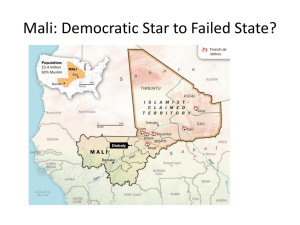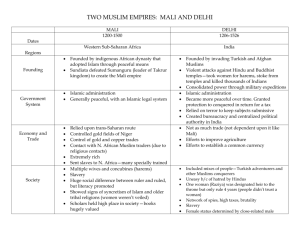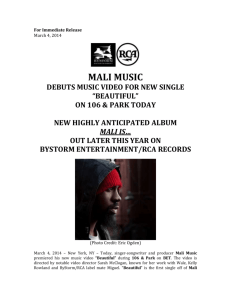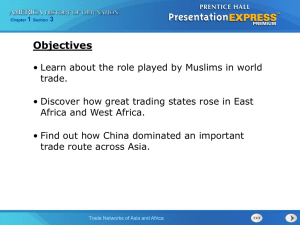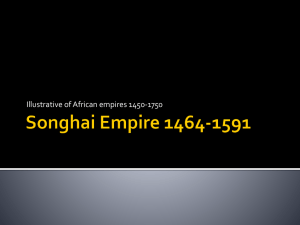Mali Unit Plan - Elementary Social Studies and History Help
advertisement
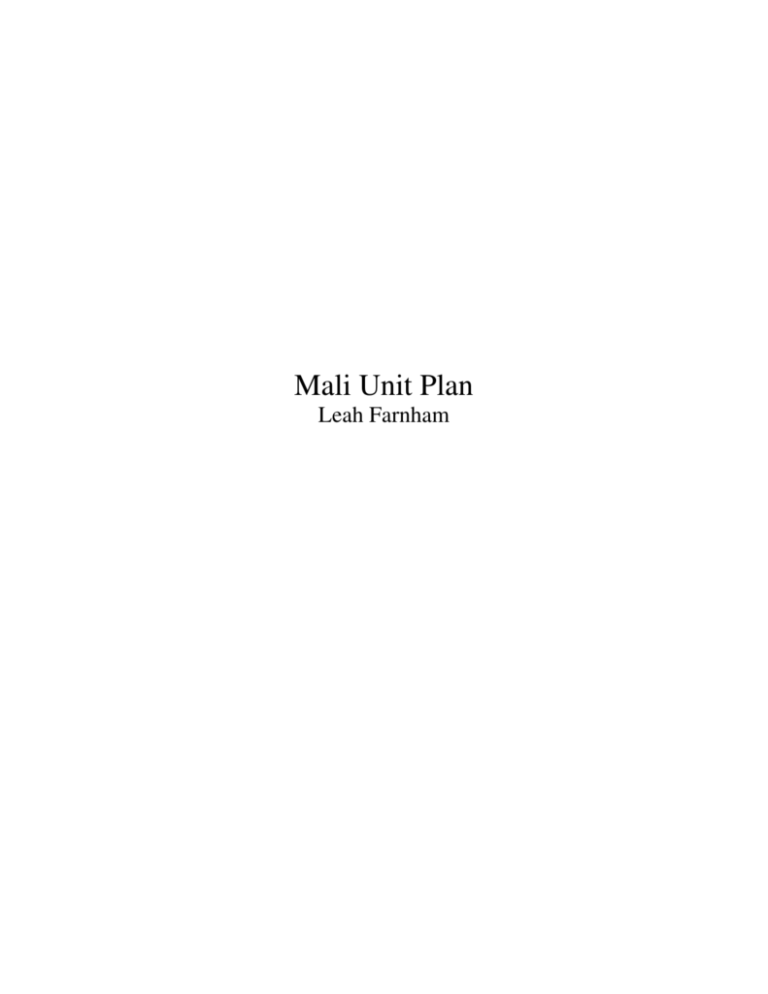
Mali Unit Plan Leah Farnham Title: Mali Grade: 3 Time: 10 days I. Introduction: The students will gain an understanding of the history of Mali. They will learn about what it was like to be a citizen of this empire, the governmental structure, the trade system, and the importance of oral tradition. In order for the student to produce well-developed stories about Mali, the unit will be extended into the following week via learning centers. They students will use learning centers the week after the majority of the content has been taught to polish their stories and presentations. This unit will integrate Art, Language Arts, Math, and Social Studies. II. Objectives: A. General Objectives ♦ Third Grade Social Studies SOL 3.2: The student will study the early West African empire of Mali by describing its oral tradition (storytelling), government (kings), and economic development (trade). ♦ Third Grade Social Studies SOL 3.4: The student will develop map skills by A) locating West Africa B) describing the physical and human characteristics of West Africa C) explaining how the people of West Africa adapted to and/or changed their environment to meet their needs B. Specific Objectives ♦ The students will demonstrate their knowledge of the lifestyle in Mali by creating a portrait of themselves as a Mali citizen and explaining it using Photo Story. ♦ The students will describe the government in Mali by decorating a cardboard crown with items representing at least three facts and creating a legend to go with the crown that explains the linkages. ♦ The students will combine their knowledge of fractions and the Mali trade system to participate in sample marketplace where they will trade goods and be taxed by the king. ♦ The students will demonstrate their knowledge of storytelling and the Mali civilization by creating their own story about one of the provided topics. ♦ The students will demonstrate their knowledge of Mali by passing a test and presentation skills through the presentation of their stories. III. Daily Plans: see attached. IV. Evaluation: ♦ I will assess the students’ knowledge of the lifestyle in Mali by viewing their Photo Story presentations and taking anecdotal notes about their comprehension. ♦ I will assess the students’ comprehension of the government in Mali by viewing their crowns and reading their legends. ♦ I will assess the students’ comprehension of the trade system in Mali and fractions by watching them give taxes to the king and the marketplace transactions. I will take notes to document student progress. ♦ I will also read the students’ paragraphs about the trade system to see what I may need to re-emphasize. ♦ I will meet with each student individually over the next week. During our meetings, I will look over their story grids and stories to make sure they are meeting the objectives. ♦ I will evaluate the students on their presentations with regards to the inclusion of all the story elements. ♦ I will also evaluate their partner review sheets and use my anecdotal notes taken. ♦ I will read over their paragraphs about the student story presentations. ♦ I will grade their unit test. V. Resources: map of Mali from http://mali.pwnet.org digital camera classroom world map prop box with assorted open ended items, different color materials, various hats, different shaped bags, various goggles and glasses class computers with microphones & Photo Story program chalkboard and chalk Sundiata: Lion King of Mali by David Wisniewski blank cardboard crowns water color paint small plastic cups with water paint brushes markers crayons colored pencils plastic beads feathers pipe cleaners popsicle sticks glue scotch and masking tape white paper pencils ziploc bags labeled with north, market, or south white packing peanuts small squares of material folded pieces of paper pink beads pieces of yellow crayon walnuts trade diagram sheet baking pan story ideas sheet story grid sheet Elements of Successful Speakers sheet Thirty-Three Multicultural Tales to Tell by Pleasant DeSpain partner review sheets West African food (with allergy considerations made) Unit test *idea for trade activity comes from VA Dept. of Education Enhanced Scope and Sequence - http://www.pen.k12.va.us/VDOE/EnhancedSandS/histthree.pdf *idea for telephone from VA Dept. of Education Enhanced Scope and Sequence – http://www.pen.k12.va.us/VDOE/EnhancedSandS/histthree.pdf VMFA Mali site http://www.vmfa.state.va.us/mali_geo_hist.html Worldnet VA Mali site http://mali.pwnet.org/ A Research Guide Presentation Tips page http://www.aresearchguide.com/3tips.html Thinkquest Parts of a Story page http://library.thinkquest.org/27864/data/cyoc/parts.html Mali Lesson 1: Introduction I. Purpose ♦ The students will learn basic facts about Mali. ♦ Third Grade Language Arts SOL 3.2: The student will present brief oral reports. ♦ Third Grade Social Studies SOL 3.4: The student will develop map skills by A) locating West Africa B) describing the physical and human characteristics of West Africa C) explaining how the people of West Africa adapted to and/or changed their environment to meet their needs II. Objectives ♦ The students will demonstrate their knowledge of the lifestyle in Mali by creating a portrait of themselves as a Mali citizen and explaining it using Photo Story. III. Procedure A. Introduction ♦ Ask the students if they have ever heard of the ancient civilization of Mali. Explain that Mali was in West Africa. Ask the students what they know about Africa. ♦ Locate Africa and the country of Mali on the world map. Explain that we will be discussing the history of this country. B. Development ♦ Give students a manila folder and ask them to write their names and “Mali” on the front. ♦ Give students a map of Mali and go over the important characteristics together (the Niger River, Timbuktu, gold mining areas, farming areas, and salt mining areas). ♦ Explain that it is hot in Mali and that much of the land is covered in desert. Using the map, show the students that Timbuktu was the center of trade because it was between the salt and gold mines. ♦ Have students write on their map sheet the three main jobs in Mali (miners, farmers, and traders). ♦ Explain that miners dug holes into the earth to find gold and salt. These people worked underground most days. They had to dig and bring the resources back to the surface. ♦ Explain that farmers often raised animals (cows, sheep, goats) or grew crops (corn, rice, cotton, peanuts). Because of the dry land, farmers had to bring water from the river to help their animals and crops survive. ♦ Explain that both miners and farmers had to trade their goods to get things they needed (food, clothing). Traders exchanged goods with the farmers and miners in the marketplace. ♦ Tell the students that they are going to dress up like a citizen of Mali. They will pick one job (miner, farmer, or trader) and use the prop box to come up with an outfit. Their picture will be taken using the digital camera. ♦ Ask the students to put their map in their Mali folders. ♦ Call three students at a time to the prop box. Allow them to pick their outfits and take their pictures. ♦ After all of the students have had their picture taken, upload the pictures to the five classroom computers. ♦ Tell the students that they will need to explain and record the choices that they made using Photo Story. ♦ Give the students time to think of what they are going to say (5 minutes). ♦ Call groups of five to the computers and show them how to pull up their picture in Photo Story. Allow them to record their explanations. C. Summary ♦ Tell the students that you would like them to get into groups according to what they dressed as. Assign a table for the miners, farmers, and traders and ask the students to move to these tables. ♦ Write list headers on the board for each job. Ask each group to come up with three items that most of the people in their group used in their outfit. Give them five minutes to discuss. ♦ Ask each group for their three items and have them explain why they picked these items. IV. Materials map of Mali from http://mali.pwnet.org digital camera classroom world map prop box with assorted open ended items, different color materials, various hats, different shaped bags, various goggles and glasses class computers with microphones & Photo Story program chalkboard and chalk V. Evaluation Part A ♦ Students’ prior knowledge will be assessed during the introduction with questions about what they know about Mali and Africa in general. ♦ I will assess the students’ knowledge of the lifestyle in Mali by viewing their Photo Story presentations and taking anecdotal notes about their comprehension. VI. Differentiation ♦ By giving the students a choice in what they will dress up as and which items they will use in their outfits, they will be able to pick themes that are on their learning level. ♦ They will also be able to explain their outfits using their own language. This component will allow them to perform on their own levels MALI Mali Lesson 2: Government I. Purpose ♦ The students will learn about the government in Mali. ♦ Third Grade Social Studies SOL 3.2: The student will study the early West African empire of Mali by describing its government (kings). II. Objectives ♦ The students will describe the government in Mali by decorating a cardboard crown with items representing at least three facts and creating a legend to go with the crown that explains the linkages. III. Procedure A. Introduction ♦ Ask the students if they have ever seen the movie, “The Lion King.” Allow a few students to say what they remember about the movie. ♦ Explain that the movie is based on a king of Mali and that we are going to be learning about the government in Mali today. B. Development ♦ Bring the students to the reading rug and tell them that we are going to read a book called Sundiata: Lion King of Mali by David Wisniewski. ♦ Flip through the book and allow the children to look at the pictures. Introduce unfamiliar terms (griot=storyteller, caravan) and have students predict what they think will happen. ♦ Read the book to the students. ♦ Have them return to their seats and hand out the Mali government fact sheet. ♦ Explain that some of the things we learned about King Sundiata are on here plus other interesting things about the Mali government. ♦ Go over and elaborate on all of the points on the fact sheet and have the students raise their hands with any questions. ♦ Hand out the blank crowns. Explain to the students that they will be decorating their crowns to represent points from the fact sheet. They should pick at least three points from the sheet and connect their decorations to these facts. They will be creating a legend after they finish decorating so advise them to choose their decorations carefully and to pick those that they can explain well. Show them the sample crown and go over what each decoration represents. Instruct them not to use the same decorations on their own. ♦ Put out the decoration supplies on the back table. Call the students by table to pick their decorations. Tell them to only pick three and, if they finish early, they may come back and pick out another. ♦ Give the students about twenty minutes to decorate their crowns. ♦ Once they are done, hand out a blank piece of paper. Show them the sample legend. Explain that they should put a sample decoration on the sheet and write the fact it represents next to it. ♦ Give them about ten minutes to complete their legends. ♦ Once they finish their legends, ask them to put their government fact sheet in their Mali folders. C. Summary ♦ Read each fact aloud and ask them to raise their hands if they used it on their crown. Ask a few students for each fact what decoration they used and why. IV. Materials Sundiata: Lion King of Mali by David Wisniewski blank cardboard crowns water color paint small plastic cups with water paint brushes markers crayons colored pencils plastic beads feathers pipe cleaners popsicle sticks glue scotch and masking tape white paper pencils V. Evaluation Part A ♦ I will assess the students’ comprehension of the government in Mali by viewing their crowns and reading their legends. VI. Differentiation ♦ By giving the students a choice in what facts and materials to use, they will be able to pick ideas that are on their learning level. Government in Mali • Sundiata led a revolt against Sumanguru and became the first king of Mali. • Sundiata brought the people together and made the empire larger. • Sundiata was weak as a boy, but grew strong as a man. As king, he wore hunter’s clothes instead of royal clothes. • Trade was an important part of Mali. By taxing all trade, the government (mainly the kings) grew rich. • Mansa Musa was another king of Mali. He controlled trade and the size of the empire grew even more. • Mansa Musa divided the large empire into provinces and assigned governors to control the people. • Mansa Musa built many buildings while he was king. In Timbuktu (the trade capital), he built churches and universities. • Mali had a large army that helped control trade and in keeping peace in the empire. • The government of Mali fell apart after the death of Mansa Musa because the new king was not a strong leader. Mali Lesson 3: Trade I. Purpose ♦ The students will learn about the trade system in Mali. ♦ Third Grade Language Arts SOL 3.10: The students will write simple explanations across all content areas. ♦ Third Grade Math SOL 3.5: The student will divide regions and sets to represent a fraction. ♦ Third Grade Social Studies SOL 3.2: The student will study the early West African empire of Mali by describing its economic development (trade). II. Objectives ♦ The students will combine their knowledge of fractions and the Mali trade system to participate in sample marketplace where they will trade goods and be taxed by the king. III. Procedure A. Introduction ♦ Ask the students if they have ever traded food with anyone during lunch. Allow a few students to tell of their trades. Ask them why they traded. ♦ Explain that people trade (or barter) with things they have to get things that they want. ♦ Tell them that, like we learned earlier, this was how people in Mali got the things that they needed. B. Development ♦ Hand out the Mali trade sheet to each student. ♦ Go over the chart explaining the goods that the people from each area used to trade (people from the north & south are miners, people from the south are farmers, and people from the market are traders). Also, explain that the king taxed all citizens that came to the marketplace. Emphasize the importance of salt (it was used to preserve foods and for people’s health). ♦ Ask the students to put their sheets in their Mali folder. Tell them that we are going to have our own Mali marketplace in class. ♦ Pick a student at random to be the king of Mali. Have him/her put on his/her crown from the government lesson and sit in front of the class. ♦ Regroup the students into highest, middle, and lowest-level math learner (don’t tell them the reasoning for the grouping). Ask students to move so that each type of learner is sitting together at a table. ♦ Assign each of the three tables as a type of citizen (from the north, the market, or the south). Give the lower-level learners the market assignment, the middle-level learners the south assignment, and the higher-level learners the north assignment. Give each student a bag for the appropriate area. ♦ Tell the students that they are going to trade on the reading rug. Explain that everyone must end up with some salt and some gold since these are the most valuable goods. Write salt & gold on the board so they will remember these items. Go over the items in the bag and explain what each represents (white packing peanuts are pieces of rock salt, small pieces of material are cloth for making clothes, folded pieces of paper are books, pink beads are shells, the pieces of yellow crayon are gold, and the walnuts are nuts). ♦ Tell them that, before they can go to the market, they must pay their taxes. They have to give the king one-fifth of all of their goods. Tell them to take out their goods and separate their taxes. Once they have done this, they can line up in front of the king. ♦ Stand beside the king and check to make sure that each student has divided their goods correctly. If they have divided correctly, they can put their taxes in the king’s pan. If they haven’t divided correctly, ask them to go back to their seats and try again. Take notes on who has trouble with this aspect of the lesson. ♦ Once all of the students have paid their taxes, allow one table at a time to go to the rug until all of the students are trading. Ask them to return to their seats once they are done with their trades. ♦ Watch the students making trades and take notes. C. Summary ♦ Once all of the students have completed their trades, ask them if they all have gold and salt. ♦ Ask the students if they got everything they wanted during the trades. ♦ Ask the students if anyone thinks that they have more than everyone else. Write a few students’ item list on the board. ♦ Then, ask the king for his/her items and write this list on the board. ♦ Explain to the students that the king grew very rich from the trade in Mali. ♦ Ask the students to write a paragraph with at least five sentences about the trade system in Mali. Once they are done, ask them to put it in their Mali folders. IV. Materials ziploc bags labeled with north, market, or south white packing peanuts small squares of material folded pieces of paper pink beads pieces of yellow crayon walnuts trade diagram sheet chalkboard chalk piece of white paper pencils baking pan *idea for trade activity comes from VA Dept. of Education Enhanced Scope and Sequence - http://www.pen.k12.va.us/VDOE/EnhancedSandS/histthree.pdf V. Evaluation Part A ♦ I will assess the students’ comprehension of the trade system in Mali and fractions by watching them give taxes to the king and the marketplace transactions. I will take notes to document student progress. ♦ I will also read the students’ paragraphs about the trade system to see what I may need to re-emphasize. VI. Differentiation ♦ By grouping the students according to math ability and giving them their goods to trade accordingly, I am matching students to their learning level. The market group only had to find one-fifth of one good (gold). The south group had to find one-fifth of two goods (gold and nuts). The north group had to find one-fifth of four goods (salt, cloth, books, and shells). Malie Trade System KING He got taxes from all trade. North Miners come from the desert with salt rocks, cloth, books, and shells. Marketplace Traders have gold nuggets. South Farmers and miners come with gold nuggets and nuts. Mali Lesson 4: Storytelling I. Purpose ♦ The students will learn importance of storytelling in the society of Mali. ♦ Third Grade Language Arts SOL 3.10: The student will write stories. ♦ Third Grade Social Studies SOL 3.2: The student will study the early West African empire of Mali by describing its oral tradition (storytelling). II. Objectives ♦ The students will demonstrate their knowledge of storytelling and the Mali civilization by creating their own story about one of the provided topics. III. Procedure A. Introduction ♦ Ask the students if they have played telephone. Let a student who has explain how it works. ♦ Tell them that you are going to try it and whisper, “Mrs. Farnham loves cheese and monkeys,” into the first student’s eat. Tell them to pass the message around the room. ♦ When the message reaches the last person in the class, have them stand up and tell the class what they hear. ♦ Explain that in Mali storytellers retold the history to each generation, like we did. This is how we know about Mali now. B. Development ♦ Bring the students to the rug and tell them that I am going to tell them a story from Africa called “The Colossal Pumpkin” from Thirty-Three Multicultural Tales to Tell by Pleasant DeSpain. Go over unfamiliar terms before starting to read (colossal, dodging). ♦ Read the story and explain to the students that this story, like all stories, has some main elements. ♦ Have the students return to their tables and hand out the story grid sheet and the story ideas sheet. ♦ Explain that we are going to become storytellers. Every student is going to write and perform a story about Mali. ♦ Tell them that they have to choose a concept from the story ideas sheet to base their story on. Read the story ideas aloud and ask if they have any questions. ♦ Tell them to get out the story grid sheet. Explain that they will need to fill in every empty square on this sheet to have all of the elements of a story. Explain each element. ♦ Give the students twenty-five to thirty minutes to decide on a concept, fill in their grid, and start writing their story. ♦ At center time, set up one center for students to work in pairs. They will finish writing and practice telling their stories during this time. Have them refer to the “Elements of Successful Speakers” sheet at the learning center for tips on their performance. Also allow the students to use reference materials and Techponds to research their stories if needed. They will have four days at learning centers to practice (Monday-Thursday). C. Summary ♦ Ask students to stop working and let them know that they will get more time during learning centers over the next week. ♦ Go over the “Elements of Successful Speakers” sheet with them and tell them that this will be in their learning center. ♦ Ask students to put their story ideas and story grid sheets into their Mali folders. ♦ Tell them that they will present their stories in a week during our Mali party. We will eat West African foods and listen to each other’s stories. IV. Materials pencils paper story ideas sheet story grid sheet Elements of Successful Speakers sheet Thirty-Three Multicultural Tales to Tell by Pleasant DeSpain *idea for telephone from VA Dept. of Education Enhanced Scope and Sequence – http://www.pen.k12.va.us/VDOE/EnhancedSandS/histthree.pdf V. Evaluation Part A ♦ I will meet with each student individually over the next week. During our meetings, I will look over their story grids and stories to make sure they are meeting the objectives. VI. Differentiation ♦ By letting the students get to choose which story idea they want to pursue, they will be able to pick an idea that they are comfortable with and that is on their learning level. ♦ The students will use the story grid to self-assess their progress. ♦ I will meet with each student individually to help with any issues he/she may have. Story Ideas ♦ A farmer is on the way to the market in Timbuktu with nuts from the last harvest and gold nuggets. His camel caravan is stopped halfway to the market and men with swords tell him to give them all of his goods. ♦ A trader in the Timbuktu marketplace is approached by a poorly clothed man. All of the trader’s gold nuggets are out on his carpet for trading. The man asks the trader for food. He says that he has not eaten in five days. ♦ The sister of Mansa Musa is a beautiful woman She loves to paint pictures of the pretty land that she lives in. She is frustrated, though, because she does not agree with some of her brother’s decisions as King. ♦ The wife of a salt miner in the north country works hard every day. She hunts and gathers food for her family, takes care of the children, cleans, and cooks. But now, she is worried because her husband has not come home for two days. ♦ A farmer who raises cows makes three long trips to the river each day. Since the land is so dry, he must bring his cows water regularly. One morning when he arrives at the river, he is alarmed to see that no water can be found. Elements of Successful Speakers ⇒They know the material that they are presenting. ⇒They use their body (hands and face) to add emphasis. ⇒They do not read straight from notes. ⇒They make eye contact with the audience. ⇒They do not rush through the presentation. Name: _______________________________ Elements of a Story 1. Setting (where?): ____________________________ 2. Main Character (who?):_______________________ 3. Details about the character (at least 2): ______________________________________________________ ______________________________________________________ 4. Problem (what?):______________________________________ 5: Solution (how?):______________________________________ Mali Lesson 5: Culminating Lesson I. Purpose ♦ The students will take a test on the unit and present their stories about Mali. ♦ Third Grade Language Arts SOL 3.2: The student will present brief oral reports. ♦ Third Grade Social Studies SOL 3.2: The student will study the early West African empire of Mali by describing its oral tradition (storytelling), government (kings), and economic development (trade). II. Objectives ♦ The students will demonstrate their knowledge of Mali and presentation skills through the presentation of their stories. III. Procedure A. Introduction ♦ Tell the students that they have done a great job on their Mali studies. ♦ Explain that everyone will be presenting their stories today after we take our test and that we all need to be good listeners for each other. ♦ Administer the unit test and take it up. ♦ Tell them that after we hear the stories we will have some West African food. B. Development ♦ Hand out the partner review sheets. Ask the students to find a partner that picked a different story from themselves to work with. ♦ Read the partner review sheet aloud and explain what information the students should look for while their partners are presenting. Model a partner review session with a student in front of the class. Explain that we will have partner reviews while we eat our food. ♦ Call each student to the front of the room and allow him/her to present their story. Let the class give each student a quick round of applause. ♦ Take anecdotal notes on the presentation. ♦ After every student has presented, call the students by table to get food. ♦ Have the students sit with their partners while they eat to go over their review forms. Observe the review sessions and take notes. ♦ Have the students hand in their partner review sheet with the final copy of their stories. C. Summary ♦ Thank the students for working so hard on their stories on their Mali studies. ♦ Have the students write a paragraph about two things they learned about Mali from the story presentations. IV. Materials pencils partner review sheets West African food (with allergy considerations made) paper V. Evaluation Part A ♦ I will evaluate the students on their presentations with regards to the inclusion of all the story elements. ♦ I will also evaluate their partner review sheets and use my anecdotal notes taken. ♦ I will read over their paragraphs about the student story presentations. VI. Differentiation ♦ I will allow the students to pick their own partners and work cooperatively together which helps with student socialization and growth. ♦ The students will be graded using the story elements sheet with they have already self-checked with. Partner Review Sheet – Mali Story Name of Reviewer:________________ Name of Story Teller:______________ One thing that needs more work:___________________________ ______________________________________________________ One thing I really liked:__________________________________ ______________________________________________________


